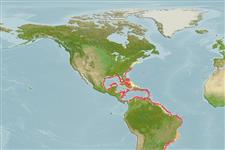>
Eupercaria/misc (Various families in series Eupercaria) >
Lutjanidae (Snappers) > Lutjaninae
Etymology: Lutjanus: Malay, ikan lutjan, name of a fish.
More on author: Cuvier.
Environment: milieu / climate zone / depth range / distribution range
экология
морской ассоциированный с рифами; пределы глубины 90 - 242 m, usually 90 - 140 m (Ref. 55). Subtropical; 41°N - 30°S, 99°W - 32°W (Ref. 55)
Western Atlantic: North Carolina, USA and Bermuda to São Paulo, Brazil (Ref. 57756). Most abundant around the Antilles and the Bahamas.
Length at first maturity / Size / Вес / Возраст
Maturity: Lm 41.6, range 24 - 26 cm
Max length : 83.0 cm TL самец/пол неопределен; (Ref. 40637); common length : 45.0 cm TL самец/пол неопределен; (Ref. 55); наибольший вес (опубликованные данные): 8.3 kg (Ref. 4699)
колючие лучи спинного плавника (общее число): 10 - 11; членистые (мягкие) лучи спинного плавника (общее число): 13-14; колючие лучи анального плавника 3; членистые (мягкие) лучи анального плавника: 7 - 8. Preopercular notch and knob weak. Pectoral fins long reaching level of anus. Scale rows on back rising obliquely above lateral line. Back and upper sides pink to red, grading to pink with a silvery sheen ventrally; sides with very fine undulating yellow lines; the fins mostly reddish or pale yellow. Young specimens (under about 25 cm) with a blackish spot on upper side below anterior dorsal soft rays.
Adults are common near the edge of the continental and island shelves; also found in deeper waters (below 200 m); usually ascending to shallow water at night. They feed mainly on fishes, shrimps, crabs, gastropods, cephalopods, tunicates and some pelagic items including urochordates. Marketed fresh. Said to be a good food fish (Ref. 5521).
Spawning occurs over most of the year in lower latitudes, but is seasonal (spring and summer) toward the northern and southern limits of the distribution.
Allen, G.R., 1985. FAO Species Catalogue. Vol. 6. Snappers of the world. An annotated and illustrated catalogue of lutjanid species known to date. FAO Fish. Synop. 125(6):208 p. Rome: FAO. (Ref. 55)
Статус Красного Списка МСОП (Ref. 130435)
Угроза для людей
Reports of ciguatera poisoning (Ref. 55)
Использование человеком
рыболовство: коммерческий; объект спортивного рыболовства: да
дополнительная информация
ссылкиаквакультура (рыбоводство)особенности рыбоводствастепень растяжениягенетикаElectrophoresesнаследуемостьболезниобработкаNutrientsMass conversion
инструменты
Специальные отчеты
Скачать в формате XML
ресурсы в Интернет
Estimates based on models
Preferred temperature (Ref.
123201): 17.3 - 25.2, mean 21.2 °C (based on 73 cells).
Phylogenetic diversity index (Ref.
82804): PD
50 = 0.5000 [Uniqueness, from 0.5 = low to 2.0 = high].
Bayesian length-weight: a=0.01479 (0.01305 - 0.01676), b=2.97 (2.94 - 3.00), in cm total length, based on LWR estimates for this species (Ref.
93245).
Trophic level (Ref.
69278): 3.1 ±0.5 se; based on diet studies.
Generation time: 11.0 ( na - na) years. Estimated as median ln(3)/K based on 2
growth studies.
устойчивость к внешним воздействиям (Ref.
120179): низкий, минимальное время удвоения популяции 4.5-14 лет (K=0.09-0.32; tm=5).
Prior r = 0.28, 95% CL = 0.17 - 0.49, Based on 2 stock assessments.
Fishing Vulnerability (Ref.
59153): Moderate vulnerability (37 of 100).
Nutrients (Ref.
124155): Calcium = 14 [7, 23] mg/100g; Iron = 0.283 [0.165, 0.486] mg/100g; Protein = 18.7 [17.2, 20.2] %; Omega3 = 0.178 [0.106, 0.300] g/100g; Selenium = 43.5 [22.3, 82.9] μg/100g; VitaminA = 65.2 [11.3, 329.9] μg/100g; Zinc = 0.326 [0.234, 0.494] mg/100g (wet weight);
